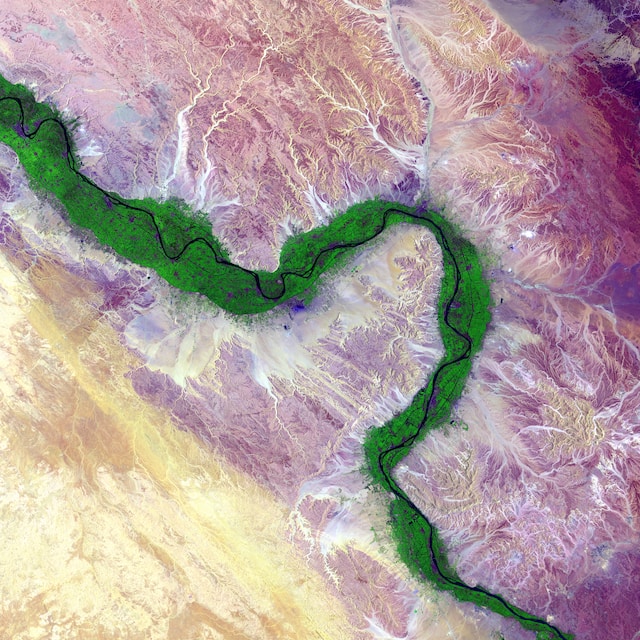If you have ever taken an African water safari, you might be familiar with popular spots like the Okavango and Victoria Falls. But if you love the extraordinary, you will find the continent’s best kept secrets in the weird waters of Africa.
These are rivers, lakes and other water bodies on the continent that have a story to tell. Some feature of the list of world’s most dangerous water bodies. Others defy basic rules of geology, while still others have remarkable speed and power.
You may have heard of some of these water bodies; but others are completely off the beaten path. Whether you love to take the road less traveled or prefer iconic destinations, there is something for all water adventure lovers.
Here are the most bizarre water-based wonders to visit on your African safari:
The Weirdest Rivers of Africa
Niger River – Weirdest Trajectory
The 4,200-kilometers (2,600 miles) long Niger River is the third longest on the continent, behind the Nile and Congo River. It is also among the 15 longest rivers in the world. This river weaves its course through four countries in West Africa, starting from Guinea, through Mali and Niger and into Nigeria.
One of the weirdest things about it is that it originates only about 240 kilometers (150 miles) from the Atlantic Ocean. However, instead of taking the typical river direction into the sea, it flows inland toward the Sahara Desert. It then takes a strange 90-degree turn, forming a boomerang shape as it heads towards the Atlantic. This unusual trajectory has baffled geographers for the longest time.
Why does the Niger River initially flow away from the Atlantic? Essentially, its flow is dictated by the terrain in flows through. History also reveals that the Niger once consisted of two separate streams. Before they joined, the first stream emptied into a now extinct lake in Timbuktu. The second originated south of Timbuktu heading toward the ocean. Due to erosion, the two connected at the point known as the Great Bend or Niger Bend. This is where the river appears to take a 90-degree turn.
Congo River – a Water World of Superlatives
Previously known as the Zaire River, the Congo River is the second longest on the continent of Africa. At a remarkable 4,700 kilometers (2,900 miles), it is the ninth longest worldwide. It also happens to be the world’s deepest river. The Congo snakes its way through seven countries:
- Congo DRC
- Congo Brazaville
- Central African Republic
- Zambia
- Tanzania
- Angola
- Cameroon
It makes our list of weird waters of Africa thanks to its immense rate of flow. Worldwide, it is second only to the Amazon in terms of the amount of water it discharges. It discharges an estimated 41,000 cubic meters of water every second into the Atlantic. (The Amazon discharges 209,000 cubic meters per second).
As the world’s deepest river, it reaches an astounding depth of 220 meters (720 feet) in some parts. Comparatively, the second-deepest river in the world, Yangtze River in China, reaches a maximum of 130 meters (430 feet).
Another distinctive feature of this river is the fact that it crosses the equator twice – the only major river in the world that does this. It is also one of the world’s most dangerous rivers for adrenaline junkies who love whitewater rafting. It has a series of perilous rapids known as the “Gates of Hell” located in a 75-miles long canyon. Equally extreme are the 60-miles rapids stretch of Stanley Falls and the 220-miles of rapids and 32 cataracts on Livingstone Falls.
River Nile, Egypt – the Mysterious Source
The world’s longest river is also among the weird waters of Africa, and for good reason. River Nile spans an impressive 6,695 kilometers (4,100 miles) and flows through 11 countries:
- Kenya
- Tanzania
- Uganda
- Rwanda
- Burundi
- Ethiopia
- Sudan
- South Sudan
- Eritrea
- Congo DRC
- Egypt
What is the Source of the Nile River?
Scientists have yet to agree on the source of the Nile. The Nile has two major tributaries, the White Nile and the Blue Nile. The two tributaries merge in Khartoum, Sudan and flow all the way into the Mediterranean Sea through Egypt. The world agrees that the source of the Blue Nile is Lake Tana in Ethiopia.
However, debate rages on as to the source of the White Nile. Though many point to Lake Victoria as its source, it emerges that this lake is in fact a reservoir feeding off of other water bodies. These include the Kagera River and Semliki River which flow from Ruwenzori Mountains. It seems safe to conclude that there is no single origin for the longest river in the world. Rather, it is the byproduct of a complex system of mighty rivers and large lakes.
Another interesting fact is that Egyptians considered it sacred and worshipped a god of the Nile known as Hapi. A statue of Hapi was among the artifacts discovered in one of the lost cities of Africa, the underwater city of Thonis-Heracleion in Egypt.
Like the Niger, the Nile takes a surprising detour in the Sahara Desert, abruptly turning to flow away from the sea. The Great Bend takes a U-shape and is about 300 kilometers (186 miles) long. It is linked to the Nubian Swell – an underground rock formation that acts as a natural barrier. The river resumes its course once it completes this diversion.

Africa’s Most Bizarre Lakes
Lake Natron, Tanzania – Colorful and Toxic Ecosystem
Almost everything about Lake Natron is unusual. It is characterized by strange colors which change from time to time. It turns reddish due to a high population of a red algae species known as halophiles. Other times, it has various shades of pink and orange. These could be the result of microorganisms or varying mineral concentrations in different parts.
The root cause behind this is the extremely high alkalinity levels of its waters. It receives most of its flows from hot springs in mineral-rich volcanic surroundings. Since it has no outlet, the levels of sodium, salt and magnesium are extraordinarily high. The water’s temperature at times rises as high as 60 degrees Celsius. This blend of factors makes the lake highly inhospitable to life.
However, microorganisms like cyanobacteria thrive here in very high levels. Many animals that drink this water die from the aftereffects of consuming these algae. The high mineral levels of these water mummify any animals that die in the lake.
Interestingly, more than two million flamingoes flock to these deadly waters to breed every year. They feed on the very microorganisms that kill most other creatures. Note that the water is deadly to human beings due to the high temperatures and mineral levels. So whatever else you do, do not swim here.
Lake Retba, Senegal – one of the Saltiest Water Bodies on Earth
Popularly known as Pink Lake, Lake Retba in Senegal is yet another example of the weird waters of Africa. It is one of the saltiest lakes on the planet with a concentration of about 40%. For context, the salinity of the Dead Sea is about 34.2%.
The high salinity makes it impossible to swim here – the best you can do is float. The miners who extract salt from this lake cover their skin in shea butter for protection. So, if you have to spend time in the salty water, take due precautions. It is interesting to note that the lake was once a freshwater body. It only turned salty in the 1980’s due to severe drought.
Its bizarre pigmentation comes from high populations of an algae species known as Dunaliella Salina. To see the lake at its pinkest however, you need the perfect blend algae activity, solar intensity and wind levels. Locals say that January is the best month to visit to see this fascinating natural wonder in full glory.
Strange Phenomena in Africa’s Waters
Underwater Waterfall, Mauritius

Our list of weird waters of Africa would be incomplete without this wonder of nature. The underwater waterfall off the island of Mauritius is a destination worth adding to your bucket list. It is a fascinating illusion on the Indian Ocean that will leave you spellbound. It comes as no surprise that this is a UNESCO World Heritage Site.
The phenomenon takes place in a lagoon off Le Morne Peninsula. The underwater landscape here has a gradual slope that abruptly leads to a 4,000-meter drop. This unusual landscape causes the continuous movement of silt and sand into the deep abyss. As these particles fall from shallow ocean shelves to the deep abyss, they create an illusion of a waterfall underwater.
The best way to enjoy this captivating scene is by a helicopter ride over the intriguing natural wonder. And while you are in Mauritius, check out the seven coloured earths of Chamarel – one of the weirdest natural wonders of Africa.
Unraveling the Mysteries of Africa’s Waterways
The waterways of Africa are the lifeblood of the continent. But these weird waters of Africa offer something more than a means of sustenance. They are amazing wonders of nature with mysterious aspects that have intrigued visitors and researchers alike for millennia.
Uncovering the mysteries of these rivers and lakes offers a fascinating vacation experience for any adventurer. If you are keen on discovering unusual attractions on your next holiday adventure, this would be the best place to start.

